^ Top of Page
Barrow’s Goldeneye
|
| Bucephala islandica |
Vulnerable (November 2000) |
| Barrow’s Goldeneye is a medium-sized diving duck. It has contrasting black and white plumage with a purplish black head and a white, crescent-shaped patch at the base of the bill. Females have a chocolate-brown head, greyish-brown back, and whitish flanks and belly. This duck represents an important proportion of the wintering waterfowl population in the St. Lawrence estuary, with small numbers along the Atlantic coast, including the coast of the Island of Newfoundland. While it breeds in Quebec, it is possible some breeding may also occur in insular Newfoundland. Molting groups have been found as far north as Little Ramah Bay in Labrador. |
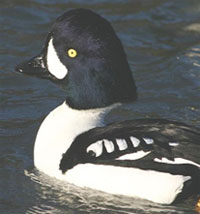 |
^ Top of Page
Bobolink
|
| Dolichonyx oryzivorus |
Vulnerable April 2015 |
| Bobolink is a medium-sized songbird found in grasslands and hayfields. The males are distinctly coloured, with a black face and underparts, white to gray shoulders and lower back to rump, and a back of the head that is straw-coloured. Females are much less conspicuous, with buffy underparts and black streaks on their sides, back and under their tail. In Newfoundland, Bobolink are rare and limited to specific habitats such as farmland, salt marshes, and grassy fields. Decline in habitat availability and quality are potential drivers of decline in the province. |
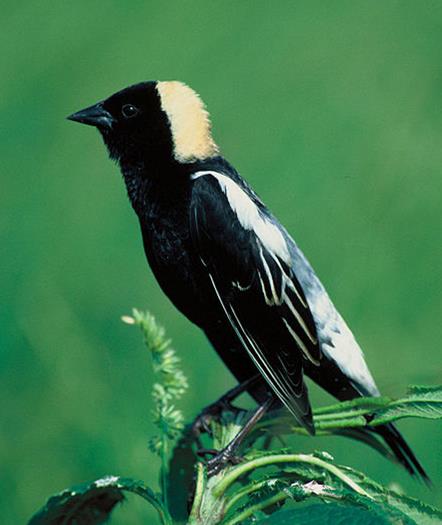 |
^ Top of Page
Common Nighthawk
|
| Chordeiles minor |
Vulnerable (2022) |
| The Common Nighthawk is a medium-sized bird, with a large, flattened head, large eyes and mouth, a small bill, longer, slender, pointed wings, and a long, slightly notched tail. Its plumage is dark brown with black, white, and buff specks and in flight; a wide white stripe can be seen across the long feathers that edge the wings. The Common Nighthawk is an aerial insectivore that feeds on a wide variety of insects at dusk or dawn. The Common Nighthawk breeds in all Canadian provinces and territories except Nunavut. In Eastern Canada it breeds only in the southern part of Labrador and is considered a rare visitor to the island of Newfoundland. In Canada, data from the Breeding Bird Survey indicate a significant long-term decline of 4.2% per year. |
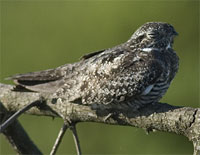 |
^ Top of Page
Eskimo Curlew
|
| Numenius borealis |
Endangered (May 2000) |
| The Eskimo Curlew is a mottled, brownish shorebird with long legs and a fairly long, thin, slightly down-curving bill. Its upper parts are brown, while its breast and abdomen are buff. It has solid brown and cinnamon coloured underwings. The Eskimo Curlew nests in the Northwest Territories and spends its winters in South America. It passes through Newfoundland and Labrador during its fall migration, and stays for a brief period on the coastal barrens, where it fattens up on berries such as the crowberry prior to making its long migratory flight south. Total numbers are unknown and sightings have been extremely rare. |
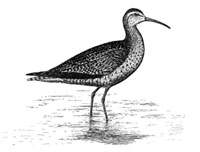 |
^ Top of Page
Harlequin Duck
|
| Histrionicus histrionicus |
Vulnerable (May 2001) |
| The Harlequin Duck is a small, subarctic sea duck. Males have a slate blue plumage, chestnut sides and streaks of white on the head and body. Its crown has a black stripe with a chestnut stripe on either side, and its belly is slate grey. Females are a plain, brownish-grey with patches of white behind, below and in front of the eye. The Eastern Harlequin Duck population breeds mostly in Québec and Newfoundland and Labrador. It winters along the eastern seaboard of the U.S.A., the Atlantic Provinces, and Greenland. Cape St. Mary’s is the main wintering site in this province. This small, colourful duck is known locally as “Lords and Ladies.†|
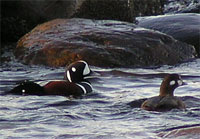 |
^ Top of Page
Ivory Gull
|
| Pagophila eburnean |
Endangered (October 2006) |
| The Ivory Gull is a small, black-legged seabird, and is the only gull with all-white plumage. Immature birds have a black face and chin, and black spots speckled along the wings and tail. This gull breeds in high-Arctic coastal areas, and winters primarily in Arctic seas, though it may be seen along the Atlantic coast, including the coasts of Newfoundland and Labrador. |
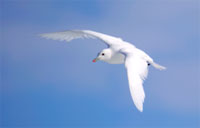 |
^ Top of Page
Newfoundland Gray-cheeked Thrush
|
| Catharus minimus minimus |
Threatened April 2015 |
| Newfoundland Gray-cheeked Thrush is a migratory bird species with brownish-olive upperparts and flanks, a cream washed breast and chestnut edging on its wings and tail. This subspecies breeds in boreal forests in Newfoundland and the south coast of Labrador and are most commonly reported from the Northern Peninsula, the northeast coast and the Avalon Peninsula. Breeding Bird Survey Data indicates a decline of over 90% in this species over the past 35 years and might be attributed to loss of habitat, nest predation, and mortality during migration and overwintering. |
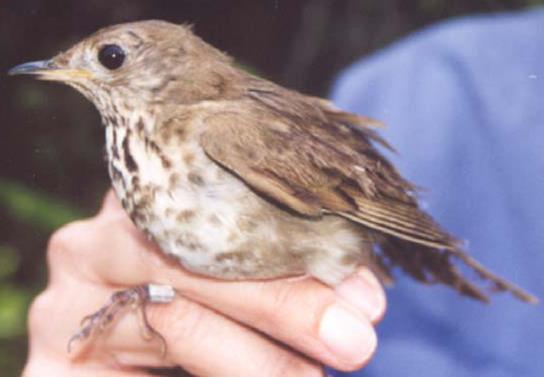 |
^ Top of Page
Olive-sided Flycatcher
|
|
Vulnerable (2022) |
| The Olive-sided Flycatcher is a medium-sized songbird. Their plumage is a deep brown to olive-grey colour, with white plumage on their throats, breast, and belly. Olive-sided Flycatchers are associated with open areas of the boreal forest, including wetlands and logged or burned areas that have tall trees or snags. They breed in both Newfoundland and southern Labrador and winter in Central and South America. The Olive-sided Flycatcher has shown widespread decline over the past 30 years. |
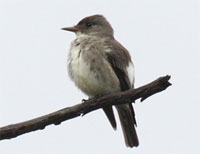 |
^ Top of Page
Peregrine Falcon
|
| Falco peregrinus anatum and Falco peregrinus tundrius |
Vulnerable (April 2007) |
The adult Peregrine Falcon is a crow-sized falcon. It has a black stripe below the eye with bluish-grey upper parts. It is buff with brown bars on the sides and thighs, and spots on the abdomen. Peregrine Falcons nest on tiny ledges on sheer cliffs along the coast of Labrador from Table Bay to Cape Chidley, and along a number of the Labrador rivers. The anatum Peregrine Falcon, which shares the area with the somewhat more common tundra Peregrine Falcon, is thought to occupy the portion of Labrador south of the tree line. The Peregrine Falcon is one of the fastest birds, migrates great distances, and has recovered from the brink of extinction and has become a symbol of wilderness and recovery.
Contact the Endangered Species Program |
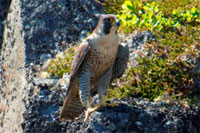 |
^ Top of Page
Piping Plover
|
| Charadrius melodus melodus |
Endangered (May 2000) |
The Piping Plover is a small, thrush-sized shorebird the colour of dry sand, with a distinctive black breast band, a black band above the forehead, and a partially black tail. It has a white rump and bright orange legs. Its orange bill is short and stout with a black tip. The Piping Plover makes a distinctive peeping call. The Piping Plover winters along the Atlantic coast and the Caribbean but breeds in Newfoundland. The Piping Plover is typically found on beaches of the southwest coast of Newfoundland, ranging from the Stephenville Crossing area in the north to Burgeo on the south coast, although in 2009 it was seen for the first time in 30 years in Gros Morne National Park. There are approximately 44 adult Piping Plovers nesting in Newfoundland.
Contact the Endangered Species Program |
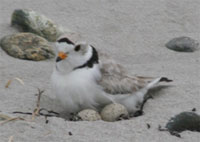 |
^ Top of Page
Red Crossbill (percna)
|
| Loxia curvirostra percna |
Threatened (2022) |
| The Red Crossbill is a small, six-inch long finch with a unique crossed bill adapted for eating seeds. Red Crossbills have been found in mature forested areas across Newfoundland. The percna subspecies is unique to the island of Newfoundland and appears to have become rare in recent years. Efforts are underway to determine if this subspecies is still breeding in insular Newfoundland. |
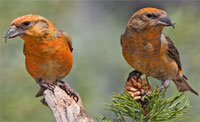 |
^ Top of Page
Red Knot
|
| Calidris canutus rufa |
Endangered (April 2007) |
| The Red Knot is a medium-sized shorebird. It has a long straight bill, small head, short neck, long legs, and long tapered wings, with an elongated and streamlined body profile. In breeding plumage, its face, neck, breast, and underparts are reddish-brown. Wings have a white stripe and feathers of upper parts are dark brown or black interspersed with red or grey. The rufa subspecies breeds only in Arctic Canada and winters in South America. During fall migration, Red Knots stopover in Newfoundland and Labrador. The rufa subspecies has experienced a 70% decline in abundance over the past 15 years, and is threatened by a decrease in food availability, primarily at migration stopover locations in the US. |
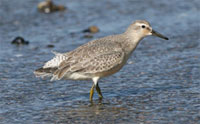 |
^ Top of Page
Rusty Blackbird
|
| Euphagus carolinus |
Vulnerable (April 2007) |
| The Rusty Blackbird is a medium-sized passerine with a slightly rounded tail that is restricted to North America. It has pale yellow eyes and a black slightly curved bill. During the breeding season, the male’s plumage turns completely black with a slight green and violet iridescence. The female’s plumage is greyish brown with no iridescence. In winter, the plumage of both sexes is rust-coloured. Within Newfoundland and Labrador, the Rusty Blackbird is thought to occur throughout the boreal forest, breeding in forest wetlands, bogs, meadows, marshes, and swamps. It overwinters in the United States. Approximately 70% of the world population breeds in Canada, but monitoring suggests a decline of up to 85% since the mid 1960s. |
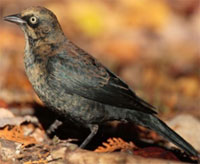 |
^ Top of Page
Short-Eared Owl
|
| Asio flammeus |
Threatened (2022) |
| The short-eared owl is a medium-sized, buffy-white owl with short, inconspicuous ear tufts. Its upper parts are broadly but softly streaked. It has narrow brown streaks on its abdomen, yellow eyes, and a black patch near the wrist under the wing. In Newfoundland and Labrador, it is found primarily in coastal areas, grasslands, and other open habitats, but moves in response to changes in the abundance of small mammal prey species. It is one of our province’s few native owl species. |
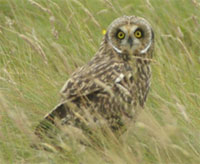 |
^ Top of Page
Adobe® Acrobat® Reader software can be used for viewing PDF documents. Download Acrobat® Reader for free.














